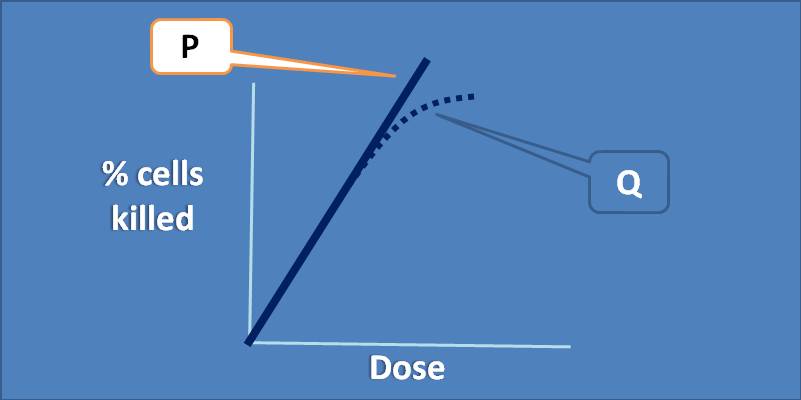- Home >
- Test papers >
MCQ on anticancer agents: Page-3

(A) P is Cell cylce specific
(B) Q is Cell cycle non-specific
(C) Both P and Q are cell cycle specific
(D) Both P and Q are cell cycle non-specific
Cell cycle dependent drugs show increase in cell killing as the dose increases up to certain dose after which they show a plateau phase even the dose is increased as all the dividing cells are killed and no dividing cell is available as drug target. Examples of these drugs include, vinca alkaloids, taxanes, etoposide which act on M phase and Antimetabolites acting on S phase. Bleomycin, even acts by breakage of DNA strands, still cell cylce specific. Cell cycle independent drugs mainly include alkylating agents like carmustine, cyclophosphamide and cytotoxic antibiotics like dactinomycin and platinum compounds like cisplatin.
(A) Bleomycin, DNA fragmentation
(B) Fludarabine, DNA polymerase inhibitor
(C) Pemetrexed, thymidylate synthetase
(D) Mitomycin, bifunctional alkylating agent
Methotrexate inhibits DHFR. Related drugs are pemetrexed and raletrexed with additional actions. Pemetrexed inhibits thymidylate transferase and raletrexed inhibits thymidylate synthetase.
(A) Sulfamethoxazole
(B) Vincristine
(C) 6-Mercaptopurine
(D) Methotrexate
Methotrexate is an antimetabolite that inhibits DHFR is weakly acidic and forms crystals in urine. Frequent hydration and alkanization of urine can control crystalluria. Sulfamethoxazole also produces crystaluria but it is not an anticancer agent.
(A) Methotrexate
(B) Vincristine
(C) Mercaptopurine
(D) Dactinomycin
P is purine thiol (mercaptopurine), O is oncovin (vincristine), M is methotrexate and P is prednisolone
(A) Dactinomycin
(B) Exemestane
(C) 5-fluorouracil
(D) 6-Mercaptopurine
5-fluorouracil inhibits thymidylate synthetase enzyme thereby inhibits the conversion of deoxy uridine monophosphate (dUMP) into deoxythymidine monophosphate (dTMP) leading to decreased synthesis of thymidine.